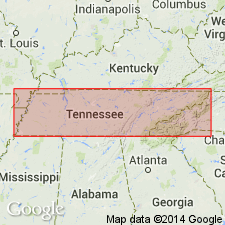
- Usage in publication:
-
- Chilhowee sandstones and shales
- Modifications:
-
- Original reference
- Dominant lithology:
-
- Sandstone
- Shale
- AAPG geologic province:
-
- Appalachian basin
Summary:
Pg. 149, 152-153. Chilhowee sandstones and shales. Great group of dark-gray, micaceous, sandy shales and sandstones, and grayish white quartzose layers, several thousand feet thick, composing Chilhowee Mountain, in Sevier and Blount [Counties], eastern Tennessee. Near upper part of formation, more or less in all the Unaka Counties, heavy beds of grayish white quartzose sandstone occur, generally freely pierced by peculiar rod-like fossil SCOLITHUS [SKOLITHOS] LINEARIS. Underlies Cambrian (provisionally) Magnesian limestone and shale group (Calciferous sandstone) and overlies Azoic Ocoee conglomerates and slates. [Age is Early Cambrian.]
Source: US geologic names lexicon (USGS Bull. 896, p. 430).
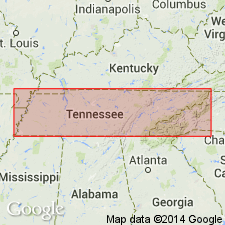
- Usage in publication:
-
- Chilhowee sandstone
- Modifications:
-
- Revised
- AAPG geologic province:
-
- Appalachian basin
Safford, J.M., and Killebrew, J.B., 1876, Elementary geology of Tennessee: Nashville, TN, 255 p.
Summary:
(and Resources of Tennessee, 1874). Included in Chilhowee sandstone all beds between †Knox sandstone (Rome formation) and †Ocoee group. This usage probably did not include the so-called "Beaver" limestone, which was discriminated many years later.
Source: US geologic names lexicon (USGS Bull. 896, p. 430).
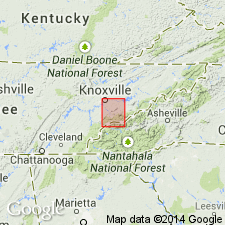
- Usage in publication:
-
- Chilhowee group*
- Modifications:
-
- Revised
- AAPG geologic province:
-
- Appalachian basin
Summary:
Mapped the rocks of Chilhowee Mountain as consisting of (descending) Hesse sandstone, Murray shale, Nebo sandstone, Nichols shale, Cochran conglomerate, and Sandsuck shale. [Age is Early Cambrian.]
Source: US geologic names lexicon (USGS Bull. 896, p. 430).
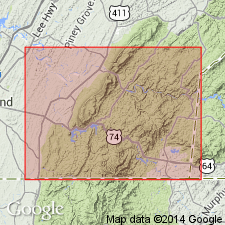
- Usage in publication:
-
- Chilhowee group
- Modifications:
-
- Areal extent
- AAPG geologic province:
-
- Appalachian basin
Summary:
Chilhowee group of Chilhowee Mountain consists of (descending): shale, 300 feet; fine white sandstone, 800 feet; shale, 800 feet; white sandstone, 500 feet; shale, 1,000+ feet; white sandstone, 700 feet; and, at base, Chilhowee conglomerate, 700 feet. [Age is Early Cambrian.]
Source: US geologic names lexicon (USGS Bull. 896, p. 430).
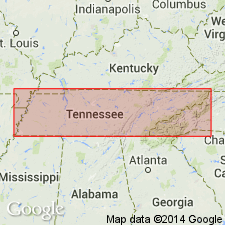
- Usage in publication:
-
- Chilhowee sandstone
- Modifications:
-
- Revised
- AAPG geologic province:
-
- Appalachian basin
Summary:
Chilhowee sandstone of Chilhowee Mountain includes (descending) Murray shale, Nebo sandstone, Nichols shale, Cochran conglomerate, Sandsuck shale, and Starr conglomerate. [Age is Early Cambrian.]
Source: US geologic names lexicon (USGS Bull. 896, p. 430).

- Usage in publication:
-
- Chilhowee group
- Modifications:
-
- Overview
- AAPG geologic province:
-
- Appalachian basin
Summary:
Chilhowee group. The USGS draws base of Chilhowee group at base of Cochran conglomerate and top at top of Hesse sandstone. According to C. Butts, OLENELLUS and
brachiopods occur at top of Hesse quartzite and at top of Erwin quartzite and lowest fossils found occur in Murray slate, and consist of OLENELLU and brachiopods. Age is Early Cambrian. Recognized in eastern Tennessee and western North Carolina.
Source: US geologic names lexicon (USGS Bull. 896, p. 430).
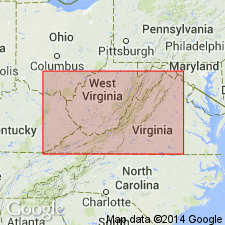
- Usage in publication:
-
- Chilhowee group*
- Modifications:
-
- Revised
- AAPG geologic province:
-
- Appalachian basin
Summary:
Name extended into VA although the group there may not be exactly equivalent to group in Chilhowee Mountain, TN. Two sets of formation names have been given individual members of group in VA. Names used north of Roanoke are Loudoun formation, Weverton sandstone, Harpers shale, and Antietam sandstone. Names south of Roanoke are Unicoi formation, Hampton shale, and Erwin quartzite. The Unicoi is equivalent to the Loudoun and Weverton. Underlies Shady-Tomstown dolomite. Group is basal Cambrian.
Source: GNU records (USGS DDS-6; Reston GNULEX).
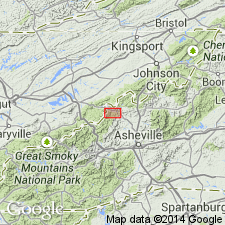
- Usage in publication:
-
- Chilhowee group
- Modifications:
-
- Revised
- AAPG geologic province:
-
- Appalachian basin
Summary:
In Hot Springs area, NC, group comprises (ascending) Vann quartzite (new), Sandsuck shale, Cochran quartzite, Nebo quartzite, Murray shale, Hesse quartzite, Shady dolomite, and Rome formation. Lies unconformably above early Precambrian granite gneiss. Age is Early Cambrian.
Source: GNU records (USGS DDS-6; Reston GNULEX).
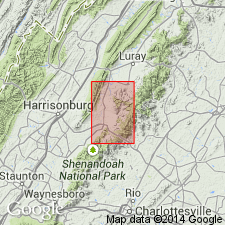
- Usage in publication:
-
- Chilhowee group*
- Modifications:
-
- Revised
- AAPG geologic province:
-
- Appalachian basin
Summary:
Group described in Elkton area, VA, where it comprises (ascending) Loudoun, Weverton, and Harper formations and Antietam quartzite. Overlies Catoctin greenstone; underlies Tomstown dolomite. Base of group considered base of Cambrian.
Source: GNU records (USGS DDS-6; Reston GNULEX).
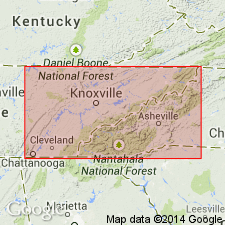
- Usage in publication:
-
- Chilhowee group
- Modifications:
-
- Revised
- AAPG geologic province:
-
- Appalachian basin
Summary:
Group mapped in eastern TN. Overlies Ocoee series and Mount Rogers volcanic complex or, where they are absent, the crystalline complex. Southwestern sequence comprises (ascending) Cochran conglomerate, Nichols shale, Nebo sandstone, Murray shale, and Hesse sandstone with Helenmode member at top. Northeastern sequence comprises (ascending) Unicoi, Hampton, and Erwin formations; Erwin formation has Helenmode member at top. Underlies Shady dolomite. Age is Early Cambrian.
Source: GNU records (USGS DDS-6; Reston GNULEX).
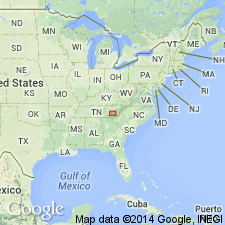
- Usage in publication:
-
- Chilhowee group*
- Modifications:
-
- Age modified
- AAPG geologic province:
-
- Appalachian basin
Summary:
Pg. 955 (table 1), 964. Chilhowee group. Group has for many years been classed by the USGS as Cambrian on basis of occurrence of trilobites, brachiopods, and other fossils in its upper part, the occurrence of SCOLITHUS [SKOLITHOS] in upper and middle parts, the sedimentary homogeneity of the group, and the presence in many places of a well-marked unconformity at base. Relations are confused, however, because in places the Chilhowee lies on earlier sedimentary and volcanic rocks with only minor unconformity, or even conformably, and many geologists have termed these earlier rocks Cambrian also; the underlying Ocoee was thus placed in the Cambrian by Keith. Paleontological data to fix as Cambrian the age of the Chilhowee group itself are decisive only for its upper part. The USGS now restricts beds classed as Cambrian to those for which paleontological data are available. Helenmode formation at top of Chilhowee group is classed as Cambrian, and remaining unfossiliferous formations are termed Precambrian(?); group as a whole is classed as Cambrian and Precambrian(?).
Source: US geologic names lexicon (USGS Bull. 1200, p. 769-770).
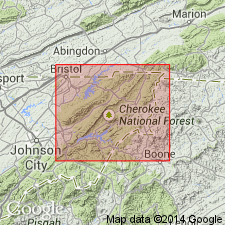
- Usage in publication:
-
- Chilhowee group*
- Modifications:
-
- Revised
- AAPG geologic province:
-
- Appalachian basin
Summary:
In Carter and Johnson Cos., TN, group comprises (ascending) Unicoi, Hampton, and Erwin formations. Overlies Mount Rogers volcanic group; underlies Shady dolomite. Age is Early Cambrian.
Source: GNU records (USGS DDS-6; Reston GNULEX).
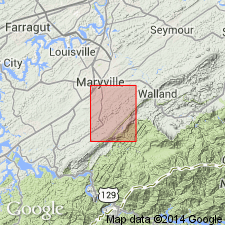
- Usage in publication:
-
- Chilhowee group*
- Modifications:
-
- Geochronologic dating
- AAPG geologic province:
-
- Appalachian basin
Summary:
In Blockhouse quad., TN, group includes (ascending) Cochran formation, Nichols shale, Nebo quartzite, Murray shale, Hesse quartzite, and Helenmode formation. Overlies Wilhite formation of Walden Creek group and underlies Maryvale limestone of Conasauga group. Sequence is broken by faulting. Most of Chilhowee group is now questionably assigned to Early Cambrian because recoverable fossils of Early Cambrian age are confined to Helenmode formation. Age, therefore is Early Cambrian and Early Cambrian(?). An Rb-Sr age determination of 584+/-30 m.y. was made from glauconite in sample of Murray shale.
Source: GNU records (USGS DDS-6; Reston GNULEX).
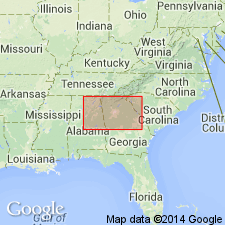
- Usage in publication:
-
- Chilhowee Group*
- Modifications:
-
- Revised
- AAPG geologic province:
-
- Piedmont-Blue Ridge province
Summary:
The Chilhowee Group in the Bill Arp and Rome thrust sheets in GA and AL includes, in ascending order, the Cochran, Nichols, Wilson Ridge, and Weisner Formations. Age is Early Cambrian.
Source: GNU records (USGS DDS-6; Reston GNULEX).
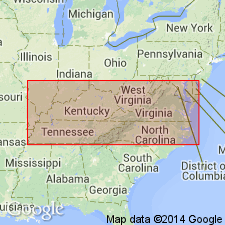
- Usage in publication:
-
- Chilhowee Group
- Modifications:
-
- Age modified
- AAPG geologic province:
-
- Appalachian basin
Summary:
The Chilhowee Group is probably Late Proterozoic (Vendian) to Early Cambrian (Placentian-equivalent or younger). A late Vendian(?) to early Placentian-equivalent (sub-Tommotian-equivalent) age is assigned to the Cochran and correlative Unicoi Formations. The Precambrian-Cambrian boundary is probably located somewhere within the uppermost portion of the Cochran/Unicoi interval.
Source: GNU records (USGS DDS-6; Reston GNULEX).
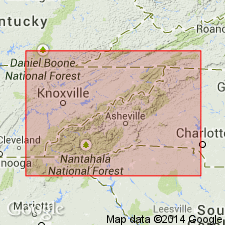
- Usage in publication:
-
- Chilhowee Group
- Modifications:
-
- Biostratigraphic dating
- AAPG geologic province:
-
- Appalachian basin
Summary:
Walker and Driese maintain that the Sandsuck, Wilhite, and Shields Formations of the Walden Creek Group form a continuous stratigraphic sequence with the overlying Chilhowee Group, which is dated here as Late Proterozoic and Early Cambrian on the basis of an assemblage of trace and body fossils--PALAEOPHYCUS, PLANOLITES, and SKOLITHOS. Precambrian-Cambrian boundary probably occurs within the middle or upper part of the basal Cochran and equivalent Unicoi Formations. Contact with the underlying Ocoee changes from conformable to slightly disconformable along depositional strike.
Source: GNU records (USGS DDS-6; Reston GNULEX).
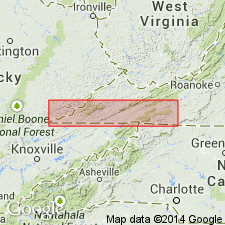
- Usage in publication:
-
- Chilhowee Group*
- Modifications:
-
- Age modified
- Biostratigraphic dating
- AAPG geologic province:
-
- Appalachian basin
Summary:
Age of Unicoi Formation of Chilhowee Group is Late Proterozoic and Early Cambrian based on limited radiometric and fossil ages; placement of paleontological zonal boundaries is problematic. Because of facies patterns and rarity of body fossils, exact placement may never be resolved. In Mount Rogers area, Simpson and Sundberg (1987) recovered RUSOPHYCUS, a trilobite resting trace, from upper part of Unicoi and a hyolithid(?) from overlying Hampton Formation. Both require an Early Cambrian age. In TN, Walker and Driese (1991) placed Proterozoic-Cambrian boundary in upper part of Unicoi based on trace fossils. Similar vertical changes in trace fossil abundances occur in Chilhowee of central VA and are restricted to first appearance of inner-shelf deposits.
Source: GNU records (USGS DDS-6; Reston GNULEX).
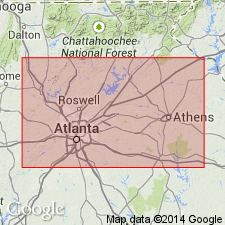
- Usage in publication:
-
- Chilhowee Group*
- Modifications:
-
- Revised
- AAPG geologic province:
-
- Appalachian basin
Summary:
In northwestern GA, Late Proterozoic to Early Cambrian Chilhowee Group of the parautochthonous continental assemblage is revised to include Pinelog Formation and its Vineyard Mountain Member (new). Pinelog contains metaconglomerate lenses that are derived from Corbin Metagranite (revised); quartzite of Pinelog contains lenses and thin layers of graphitic phyllite identical to that in Nantahala Formation. Pinelog and Nantahala may be facies of one another. Pinelog is lithologically identical to parts of Chilhowee Group exposed on Chilhowee Mountain, TN, and is in same structural position as Chilhowee in the orogen, has same relations to same Lower Cambrian units in Rome Valley to the west, and contains worm-tube molds like those found in Chilhowee in TN. Therefore, assignment is made to Chilhowee Group and age assigned is Late Proterozoic to Early Cambrian.
Source: GNU records (USGS DDS-6; Reston GNULEX).
For more information, please contact Nancy Stamm, Geologic Names Committee Secretary.
Asterisk (*) indicates published by U.S. Geological Survey authors.
"No current usage" (†) implies that a name has been abandoned or has fallen into disuse. Former usage and, if known, replacement name given in parentheses ( ).
Slash (/) indicates name conflicts with nomenclatural guidelines (CSN, 1933; ACSN, 1961, 1970; NACSN, 1983, 2005, 2021). May be explained within brackets ([ ]).

